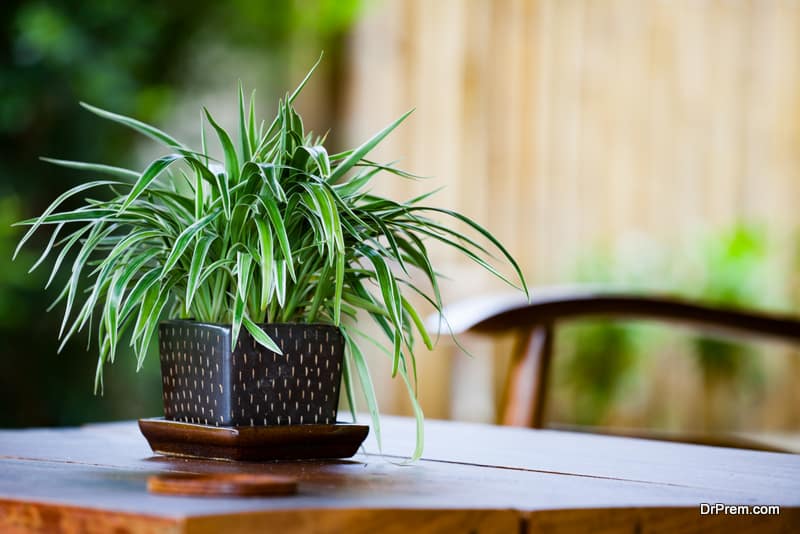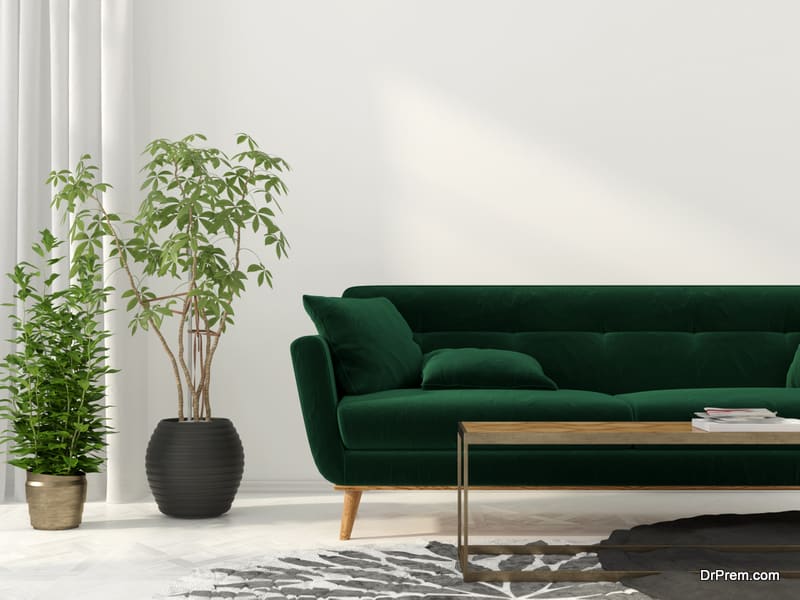Air pollution is all pervasive now, outdoors and indoors. Indoor air is polluted by cleaning agents and chemicals used in various products. The polluted indoor air is quite often at the bottom of the respiratory problems, in both adults and kids. There is a natural way to clean the indoor air, and that is with natural dehumidifier plants. Here’s a list of the most effective plants for the indoors:
11 – Natural dehumidifier plants
1. Snake plant
 The snake plant provides a beautiful, sensuous flair to the home. The plants remove humidity naturally, such as snake plants can remove air borne pollutants from the interiors. This plant is the most effective plant to remove VOC – toluene according to a study which compared the abilities of 12 indoor plants. If there is someone suffering from asthma, then this is one of the best indoor plants for asthma you can keep in your home.
The snake plant provides a beautiful, sensuous flair to the home. The plants remove humidity naturally, such as snake plants can remove air borne pollutants from the interiors. This plant is the most effective plant to remove VOC – toluene according to a study which compared the abilities of 12 indoor plants. If there is someone suffering from asthma, then this is one of the best indoor plants for asthma you can keep in your home.
2. Epiphytes
Epiphytes are the plants which grow harmlessly on objects or other plants. They get the required moisture as well as nutrients from air around them, and they are plants which reduce the humidity inside the house. Many types of ferns, bromeliads, cacti, mosses and orchids are wonderful epiphytes which add elegance to the decor and remove moisture. Orchids are sensual and gorgeuos and will up the decor of your home a few notches.
3. Aloe Vera
 This is another common plant whose numerous properties make it a valuable addition to your home. It can remove humidity naturally, and filter pollutants such as benzene and formaldehyde. It can be used in home remedies for skin problems especially.
This is another common plant whose numerous properties make it a valuable addition to your home. It can remove humidity naturally, and filter pollutants such as benzene and formaldehyde. It can be used in home remedies for skin problems especially.
4. Cacti
Cacti are xerophytes which are typically desert plants and need very little water. They can survive in high temperatures as well. Most cacti have waxy/hairy leaves and have thick stems which can store water and reduce humidity. There are thousands of varieties of cacti, and you can choose one which you really like. There are very pretty cacti which flower in certain seasons, and can be a good decor element in the home.
5. Spider plant
 Spider plant is an easy to grow indoor plant, and was found to be one of the natural dehumidifier plants which are graceful and elegant to look at. It removes ethylbenzene effectively, is low maintenance, needs low light and has an impressive appearance.
Spider plant is an easy to grow indoor plant, and was found to be one of the natural dehumidifier plants which are graceful and elegant to look at. It removes ethylbenzene effectively, is low maintenance, needs low light and has an impressive appearance.
6. Spade leaf philodendron
Spade leaf was the subject of a study by NASA, to test its efficiency to remove large concentrations of benzene, carbon monoxide and formaldehyde. It was found to be very effective and remove toxic air from the home, thus preventing medical conditions ranging from cell mutations, respiratory problems and sudden death.
You can choose this plant as it is extremely hardy and grows abundantly. This is one of the plants which absorb moisture and keeps your home pollutant free.
7. Peace Lily
 This is one of the best plants to remove humidity naturally, and is also one of the most pleasant, calming plants in your home. It removes most pollutants, including N-hexane which is emitted by wood finish and lacquers. N-hexane is linked to many health issues, including sensory loss. Peace lilies should be kept from children’s reach for safety, as they might be toxic when they are consumed by mistake.
This is one of the best plants to remove humidity naturally, and is also one of the most pleasant, calming plants in your home. It removes most pollutants, including N-hexane which is emitted by wood finish and lacquers. N-hexane is linked to many health issues, including sensory loss. Peace lilies should be kept from children’s reach for safety, as they might be toxic when they are consumed by mistake.
8. Tillandsia
The tillandsia plant flourishes when kep indoors, especially when kept on sunny windowsills. The sunlight which is filtered is best for the tillandsia. It absorbs the moisture in the air as well as nutrients through the leaves. This indicates that the plant can be a very good natural humidifier inside the home. It requires regular watering, two or three times in a week, in order to survive.
If they receive less water, then their leaves’ shape will become more concave than they actually are. Some plants release more moisture to the air, so when there is excess moisture in the home, and increasing the number of tillandsia might improve the air quality of the house.
9. English Ivy

English Ivy is known to be one of the best indoor plants for asthma, as well as chronic bronchitis. Formaldehyde is a known carcinogen which is found in household cleaners, furniture polish, particleboard, glues, plywood and certain fabrics. So with English Ivy, you can battle health hazards such as formaldehyde naturally.
English Ivy has been found to be particular effective in removing airborne molds which grow in humid areas/places in homes. This is one of the best natural dehumidifier plants, and it can be grown in a number of ways. It can be planted in hanging pots, which is closer to the ceiling, so that the humidity which is higher up can be absorbed. It grows a little slowly in the beginning, but keeping the soil moist will help it thrive. It needs little sunlight, so can be kept indoors successfully.
10. Reed palm
Reed palms are just like other varieties of palms which can absorb moisture through the leaves. Reed palms do well in low light, making it perfect for the home, and it can grow many feet tall if you put in an area of strong light. The soil has to be kept a little moist, if you want the reed palm to grow to the best of its ability. It is one of the best natural dehumidifier plants which will beautify a corner of the home, add to its beauty and keep the moisture away.
11. Boston Fern

The Boston Fern is a popular fern as it has decorative leaves with slender fronds. It is an effective purifier plant which eliminates pesky pollutants like xylene, benzene and formaldehyde. Boston ferns prefer moist soil, indirect sunlight and daytime temperatures. If the region where you live is dry and cold, then misting the plant from time to time will keep it healthy.
Elevated moisture levels in your home can lead to many health problems. Instead of a humidifier, you can use plants to dehumidify your home and keep the air healthy. These plants soak up the clammy air and the mustiness from your home, especiallu during cold, damp seasons.




